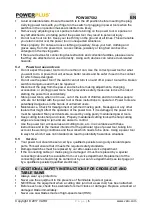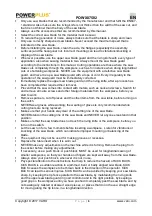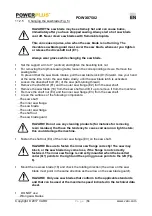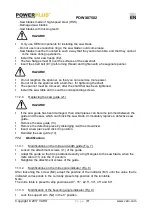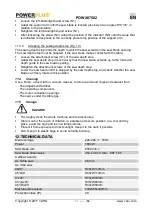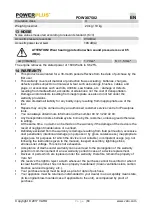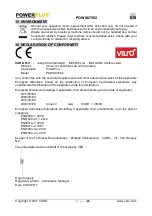
POWX07582
EN
Copyright © 2017 VARO
P a g e
|
12
www.varo.com
Lower the saw head carefully and completely downwards while holding firmly onto the
handgrip. You should only apply medium pressure while sawing, so as to prevent that the
speed of the motor slows down.
Saw the workpiece in one single movement.
Carefully let the saw head return to its topmost starting position.
The saw should be switched off by releasing the switch (20), if no further sawing has to be
done.
Note: The mitre saw is activated at certain angles, such as at 0°, 15°, 22.5°,
30°, 45° and 60°.
10.1.6
Bevelling
During bevelling, the workpiece is sawn at an angle of less than 90°.
Starting position:
Saw head completely raised.
Motor head in the 0° position; the locking screw of the turntable is tightened.
10.1.7
Sawing the workpiece:
Release the bevelling locking knob (16) for tilting the saw head close to the saw.
Tilt the motor head carefully to the desired position.
Tighten up the bevelling lock knob (16).
Hold the workpiece against the mitre and width guide. If necessary, use a work clamp for
fastening the workpiece.
Activate the switch (20) and activate/push on the safety lock (6).
Lower the saw head carefully and completely downwards, while firmly holding onto the
handgrip. You should only apply medium pressure while sawing, so as to prevent that the
speed of the motor slows down.
Saw the workpiece in one single movement.
Carefully let the saw head return to its topmost starting position.
The saw should be switched off by releasing the switch (20), if no further sawing has to be
done.
10.1.8
Double mitre cut
A double mitre cut is a combination of a mitre cut and a bevelling cut; this means that the
workpiece is cut at an angle in the one single movement, which is not equal to 90° in
relation to the mitre and width guide and the material surface.
HAZARD! The saw blade is exposed much more than normally when
making a double mitre cut, which leads to an increased risk of injuries.
Always keep sufficient distance from the saw blade.
Starting position:
Saw head completely raised.
Mitre saw locked in the desired position.
Saw head tilted at the desired angle, in relation to the surface of the workpiece, and locked
in position.
10.1.9
Sawing the workpiece:
Hold the workpiece against the mitre and width guide. If possible, use a work clamp for
fastening the workpiece.





